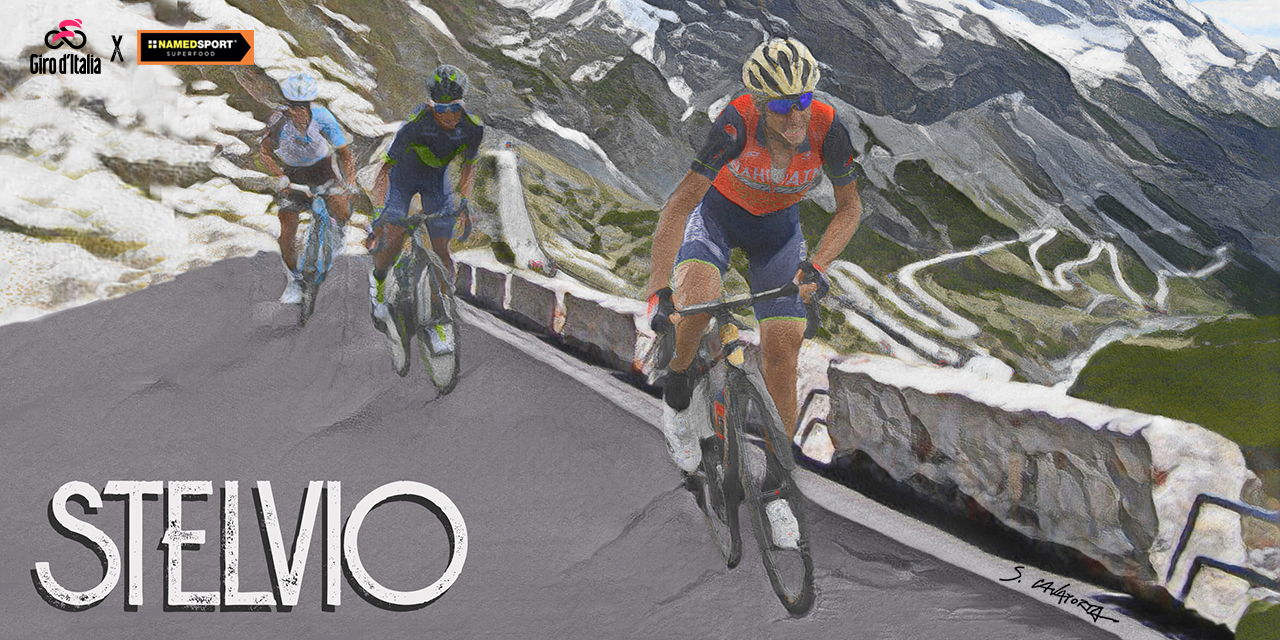The alpha and the omega
While the Pordoi marked the beginning of Fausto Coppi’s career at the Giro d’Italia – they made their debut together in 1940, the year in which the Campionissimo took his first overall victory – the Stelvio – rising to 2,757 metres in altitude – was the zenith, the peak and crowning glory.
The pass first featured on the route of the Corsa Rosa on June 1st 1953, on the second‑to‑last stage. By then, it looked as if, overall, everything had been settled already. In the previous stage, which finished in Bolzano, Coppi had tried has hard as he could to distance himself from the race leader, Koblet, but to no avail. The two then made a deal, which Koblet agreed to. The Campionissimo promised not to attack him the following day, in return for stage victory. With Fausto sitting 1’59” behind Hugo, the Giro was apparently over.
What happened the following day was one of those incidents that make cycling the most beautiful sport in the world. Despite being in tip-top shape, Coppi – loyal as he was – didn’t feel like breaking any truce, so he decided he would not pull away. However, should his rival attack in the first place, he would feel entitled to respond. So he asked the young Defilippis to step up the pace halfway through that new, brutal climb, which he did. With 12 km remaining to the summit, Defilippis put the hammer down, and Koblet set off to chase him – a terrible, expensive mistake.
The deal was broken. Fausto counterattacked, and proceeded to pass him, as Koblet started falling behind. Coppi cleared that unprecedented climb alone, 2’48” ahead of Bartali, 3’27” ahead of Defilippis and 4’25” ahead of Koblet, who tried to give it all along the closing climb. Riding frantically and taking great risk, the Swiss managed to shave seconds off the gap, however crashing twice on the descent, and finishing 3’28” behind. The Campionissimo took the stage, as well as the fifth overall victory of his astonishingly successful career.
That date, June 1st 1953, marked at the same time the debut of the Stelvio Pass in the history of cycling, and Coppi’s final outstanding achievement at the Giro.
It was the alpha for one and the omega for the other.
That bond, however, has never been broken. Instead, it has grown even stronger. Their names are now inseparably entwined, and everybody thinks of the Stelvio as the most iconic Cima Coppi.
2020: Stage 18, Pinzolo – Laghi di Cancano
FIRST RIDER ACROSS THE SUMMIT: Rohan DENNIS
2017: Stage 16, Rovetta – Bormio
FIRST RIDER ACROSS THE SUMMIT: Mikel LANDA MEANA
Dumoulin stopped for an emergency nature break on the lower slopes of the closing climb (Umbrailpass), as the peloton waited for him for a few minutes. Zakarin eventually pulled away, followed by Quintana, Pozzovivo and Nibali, although not at a cracking pace. Dumoulin set off on a solo chase, and managed to clear the summit 2’20” behind them. Nibali popped out when the Umbrailpass was a little more than one km away, slowly reeling in one rider after another. Along the descent, he eventually jumped across to Landa, the last one remaining from the previous break. Flying down all the way to the line, Vincenzo took a masterful sprint win, after 17 stages without an Italian winner – the longest run of misfortune in the history of cycling.
2014: Stage 16, Ponte di Legno – Val Martello
FIRST RIDER ACROSS THE SUMMIT: Dario CATALDO
Quintana stormed to victory in Val Martello, dropping Hesjedal in the stage finale, but controversy broke out over the handling of the Stelvio descent in the fog and rain. The race direction told the riders to maintain their positions, without attacking, while the Giro profile on Twitter mentioned the descent would be neutralised, hence causing confusion in the peloton. Some riders (Majka) stopped to change clothes, while others, Quintana first, rode hard to an advantage of nearly two minutes on their closest rivals by the end of the descent. Quintana snatched the leader’s jersey from his fellow compatriot Uran, who finished over four minutes back.
2012: Stage 20, Caldes, Val di Sole – Passo dello Stelvio
FIRST RIDER ACROSS THE SUMMIT: Thomas DE GENDT
2005: Stage 14, Egna – Livigno
FIRST RIDER ACROSS THE SUMMIT: José Humberto RUJANO GUILLEN
1994: Stage 15, Merano – Aprica
FIRST RIDER ACROSS THE SUMMIT: Franco VONA
1980: Stage 20, Cles – Sondrio
FIRST RIDER ACROSS THE SUMMIT: Jean-René BERNAUDEAU
With the climb to the Stelvio set at 90 km out, this was an ‘imitation’ Alpine stage which actually provided considerable room to breathe, especially for Italian riders, who contended for overall victory sprinting along the flat stretches of the stage.
Despite their technical disadvantage, Cyrille Guimard and Hinault rode masterfully. Three Renault riders broke away with 50 km to go to the top of the Stelvio. When the break reached Prato allo Stelvio, Bernaudeau pulled away, solo. Hinault, who had fallen a few minutes behind, also attacked in Prato allo Stelvio, joined by Panizza, Prim and Battaglin. After attacking repeatedly, the Frenchman eventually managed to clip off and jump across to Bernaudeau. The two continued together for a further 80 kilometres, as if in a time trial all the way to the finish in Sondrio, with their lead extending rather than shrinking. Hinault let Bernaudeau win the stage, and rode into the pink jersey. The former GC leader, Panizza, finished over 4 minutes back, while Saronni fell nearly 9 minutes behind.
1975: Stage 21, Alleghe – Passo dello Stelvio
FIRST RIDER ACROSS THE SUMMIT: Francisco GALDÓS GAUNA
Despite repeated attempts, Galdos did not succeed in dropping Bertoglio. The Italian responded each time, counter-attacking in the end. Galdos gave up on further attacks, but Bertoglio eventually left stage victory to his opponent, taking overall victory instead.
1972: Stage 17, Livigno – Passo dello Stelvio
FIRST RIDER ACROSS THE SUMMIT: Jose Manuel FUENTE
Fuente attacked along the Stelvio, pushing a virtually impossible gear ratio, and shaving two minutes off Merckx’s advantage. However, the Belgian had such a margin that his overall lead was safe.
1965: Stage 20, Madesimo – Passo dello Stelvio
FIRST RIDER ACROSS THE SUMMIT: BATTISTINI Graziano
The stage, originally designed to finish in Solda (197 km), was re-routed to the Stelvio owing to the bad weather. The racing conditions were extreme: the snow kept falling, and an avalanche was blocking road 300 metres from the finish, forcing the riders to carry their bicycles over piles of snow. Time was taken at the -400 metre marker: Adorni finished in first, sitting close to Zilioli on GC.
1961: Stage 20, Trento – Bormio
FIRST RIDER ACROSS THE SUMMIT: Charly GAUL
The route was originally designed to include climbs up the Tonale and Gavia, and to finish at Passo Resia. However, a landslide along the Gavia called for a replacement stage. Van Looy, sitting 7 minutes behind on GC, made an early breakaway and cleared the Giovo in first. By the time he reached the foot of the Stelvio, he had become the virtual Maglia Rosa, with an 8’10” lead over the peloton. The Belgian, however, cracked along the ascent. Gaul attacked and pulled away, solo. Anquetil tried to drop Pambianco: two kilometres before the summit, he was leading by one minute. Arnaldo, however, bridged across to him, leaving him behind and reaching the summit half a minute ahead of the Frenchman. Gaul took the stage, while Pambianco finished in second, shaving one minute off Anquetil’s margin, and extending his overall lead.
1956: Stage 18, Sondrio – Merano
FIRST RIDER ACROSS THE SUMMIT: Aurelio DEL RIO
Gaul punctured three times, finishing six minutes behind the winner, Maule. The location of the categorised summit along the route was poorly chosen: the Stelvio was placed halfway, ahead of 85 kilometres on descending and flat roads.
1953: Stage 19, Bolzano – Bormio
FIRST RIDER ACROSS THE SUMMIT: Fausto COPPI
The first-ever ascent to the Stelvio made this stage legendary before the riders even took the start. The previous day, Coppi already congratulated Koblet as Giro winner, but his team manager at Bianchi still urged him to have a go on the Stelvio. Coppi asked Ettore Milano to take a picture with Koblet, and when the latter took on his sunglasses, he was showing signs of weakness, which Milano reported to Coppi. The Bianchi squad pushed with all of their might since the start. When Defilipps clipped off, 12 km before the Stelvio, Coppi chased after him, while Koblet fell behind. Coppi blasted away, and crossed the line three and a half minutes ahead of Koblet, winning the Giro. After the stage, Koblet would say that he was suffering from bronchitis, he had crashed twice along the descent and he had punctured at 7 km out. However, some argued that Koblet’s fatigue didn’t actually come from bronchitis, but rather from overdoing amphetamines (which, at that time, were not banned) the previous day. Coppi rode the Stelvio in a 46×23 gear ratio.





































































































